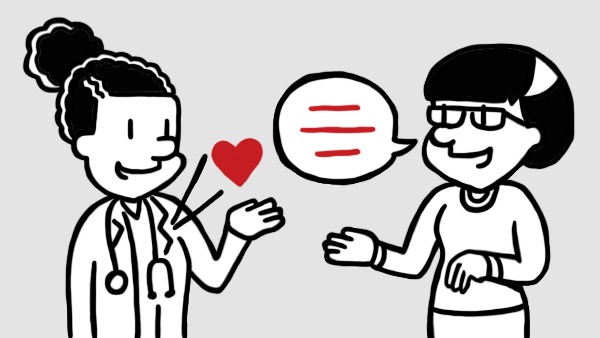Storytelling is, quite simply, a fundamental part of the human experience. We rely on storytelling to relay information, to entertain ourselves, and to make sense of our experiences and our history. The entertainment aspect of storytelling often comes first to our minds, and for this reason, we might not immediately like the idea of ‘storytelling in healthcare.’ Yet, we shouldn’t fear the approach in this often-stressful, frequently life-altering industry—we should embrace it as a great communication tool.
As Dr. Elaine Cox points out early in her argument for storytelling in healthcare, “We spend hours consuming the tales of other people through all aspects of journalism—magazines, blogs, news broadcasts and conversation.” She adds that ancestral searches and the rise of genealogical research have created an interest in “the story of [our] lives through previous generations,” and recounts an Indian proverb: “Tell me a fact and I’ll learn. Tell me a truth and I’ll believe. But tell me a story and it will live in my heart forever.”
Addressing healthcare specifically, Dr. Cox says that patient safety has benefited from storytelling, as letting patients and families discuss preventable harm events through a story has helped reveal process issues that may cause injury. These stories, she continues, add “the human aspect to the facts of a case, touching the empathy cord inside most human beings. [They add] both accountability and urgency to improvement activities.”
Kathy Ray Gaughran considers storytelling as a potential antidote to “Doctor-speak,” which she describes as “tech-talk, medical shorthand, or clinical details… the stuff that makes listeners’ eyes glaze over.” It might be strange to imagine tuning out while hearing details important or relevant to your own experience, but it can certainly happen—unless your provider is attentive in how they discuss these details.
Gaughran reminds us that patients usually pursue healthcare through an emotional lens of anxiety and fear. “The underlying reason—what they’re really looking for—is happiness,” she contends, and they’re frightened that what they hear from their doctor will take away from that happiness, in one form or another. This is why “…storytelling that leads to a happy or positive resolution would grab and hold their attention.”
And how should that story develop? In Gaughran’s estimation, much the same way any good story should: with the fundamental elements of setting, characters and plot, and moving through a narrative arc that includes a setup (establishing the situation, mood, and protagonist), rising action (detailing conflict or obstacles the protagonist must overcome), a climactic turning point, and a resolution that includes overcoming those obstacles and revelation of the essential lesson.
Importantly, it’s not only patients that benefit from storytelling in the healthcare setting—doctors gain much from the approach as well. As Dr. Andre Heuer is quoted in Healthleaders, the questions that a doctor asks to learn a patient’s story can bring out “the texture of the person’s life, and not just the data. The details begin to fill in, so it becomes a broader picture with movement and what the patient feels about the situation along the way.”
We can certainly imagine how this can happen. If a doctor were to ask a patient how many cups of coffee they drink in a week, they might struggle to come up with the answer quickly—this kind of numerically-focused, story-free inquiry feels like a test, a math problem that they haven’t had to solve until they’re on the spot.
Consider the alternative: “I’m wondering how many cups of coffee you tend to drink. Can you walk me through an average workday and tell me about how many cups you have?” With this question, the patient will be the protagonist in a story set at work, and can proceed through a recent workday memory with less pressure and more detail.
The storytelling question flows more easily from the patient, and can give the doctor more information than just the patient’s average coffee consumption. It can potentially help the doctor learn about the patient’s sleep, stress levels, eating habits, physical activity, and perhaps much more.
The story includes the data that the doctor needs, in a way the patient can easily access it. Moreover, think about how much easier it is to describe a habit in context, as opposed to in a vacuum; most of us feel better admitting that we overdo it on caffeine, to stick with the example, if we’re allowed to articulate why we overdo it. The reasons matter to the patient, and to the doctor. Not to belabor the point, but compare the following two responses:
“I think I have 16 cups in a week.”
“Well, in the morning, I have at least two, I guess, because I have to wake up—I can’t sleep more than four or five hours a night, for a while now. And I have to be sharp at work, so probably one or two more, because the pressure is enormous. And I have one before I leave, because I can’t be anything less than alert when I’m picking up my kids from school.”
Let’s conclude with Dr. Cox’s final thoughts on what she calls “narrative medicine.” As she puts it, doctors “… have a commitment to improve the human condition. That should go beyond throughput, ordering tests and writing prescriptions. It should be about connecting with humankind, understanding their journeys and developing both cultural awareness and humility. We should lead with our heart.”
Do you value storytelling at your medical practice? Do you agree that it is one of the best ways to connect to a patient, or do you prefer a more data-based approach? What about when you are the patient—does your preference shift? How might you involve storytelling more in your practice?

